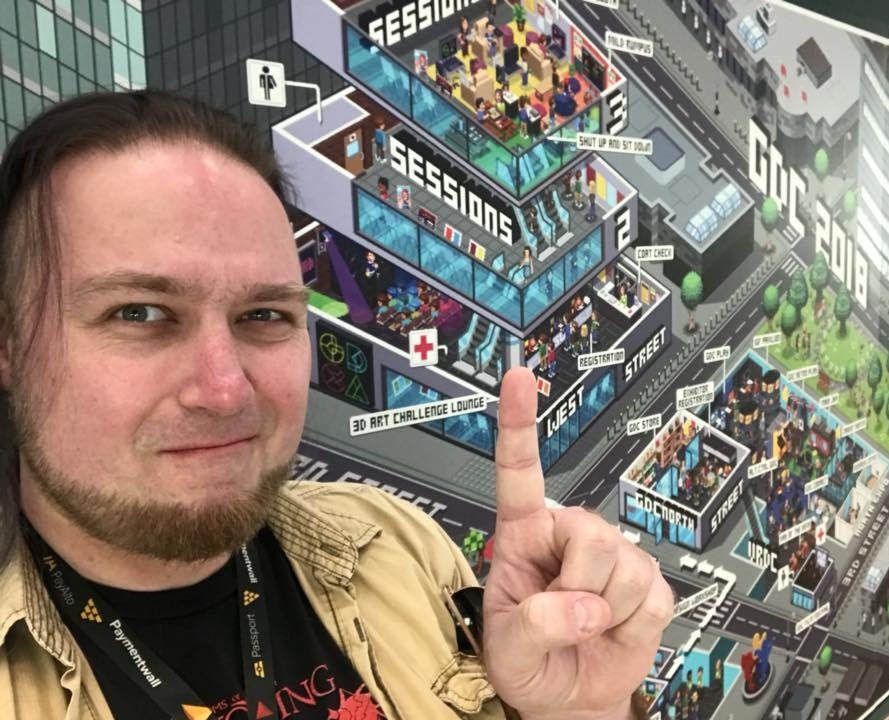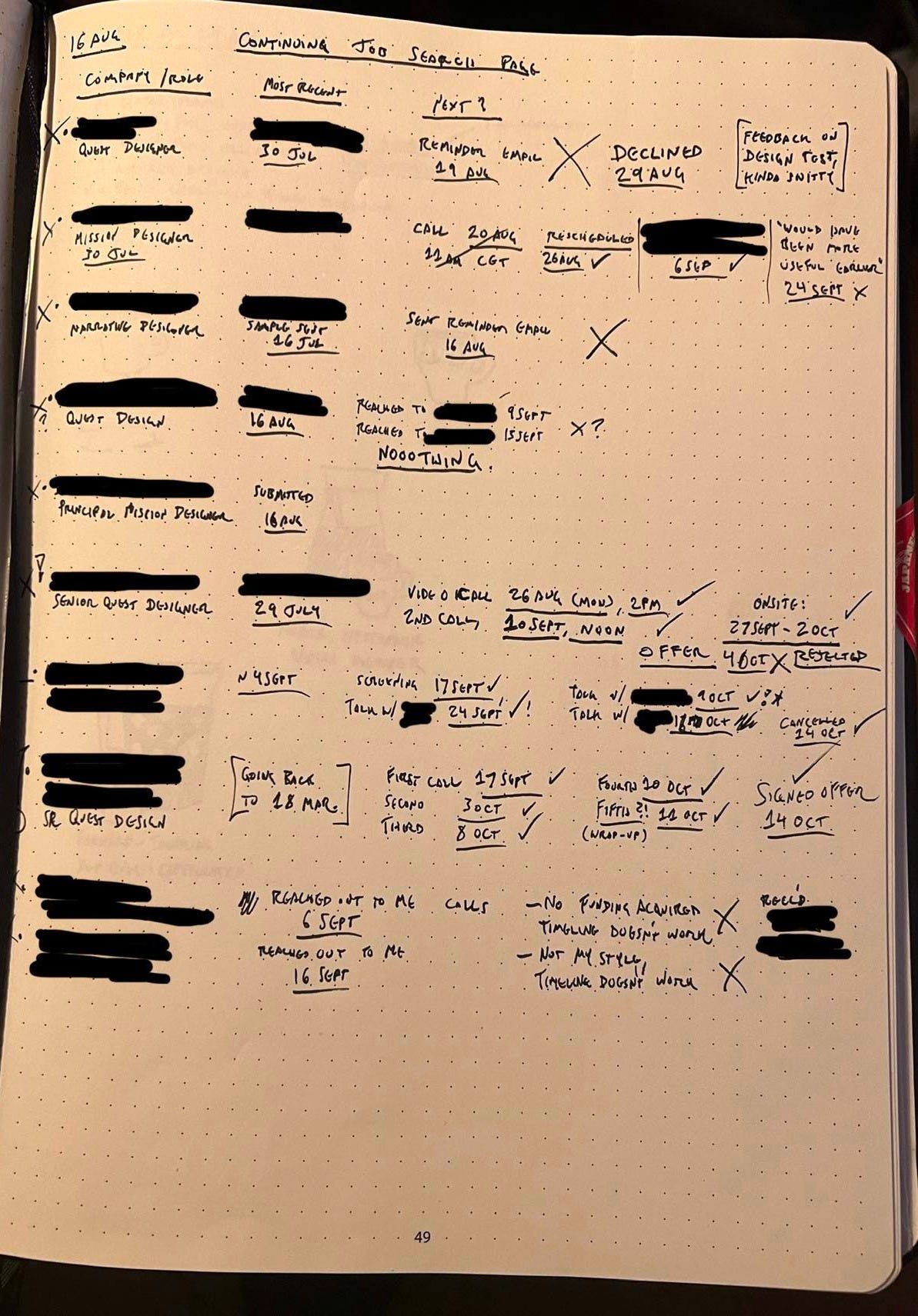The Job Hunt: Applications
The first step is the hardest. And you have to take it so many times.

As much as the job hunt sucks, there are parts that I enjoy about it — or at least, that I would enjoy if they weren’t in the context of “needing to find a new way to pay rent”.
Talking with other professionals about my work and attitude towards the craft? Love it! Engaging in thought experiments and design tests? Sure, sometimes! After all I’m a big craft nerd who liked doing homework if I thought the subject was interesting.
But applications? Those are the worst. And it’s just plain unfair that they’re the first, and most common, step of the job hunt.
I’m sure there’s a certain sort of charming extrovert for whom applications and cover letters are they’re cherished chance to make a good first impression. But for me, it’s hard to keep up that sort of one-sided enthusiasm, especially in the face of so may shut doors.
So in that spirit, we’re starting out this group of articles about the job hunt with the first and worst step, the part I hate the most: sending out applications.
Where to Apply
Obviously, the first step is looking for studio openings where you can apply.
(I mean, unless you’re very well-connected and/or prominent in the field to the point where you can reach out to a preferred studio and pitch them on hiring you. But if that’s the case, you’re not reading this article for advice.)
Nowadays, there’s no shortage of sites that you can use to find job listings these days, from the obvious social media ones to more niche sites focused on the game industry. They each have their advantages and disadvantages, so you may want to keep an eye on multiple sites to cover any issues. There’s similarly no shortage of sites that give all the basic tools for building a good resume, cover letter, and community. If you don’t already have a preference, Amir Satvat’s Games Community seems to be the hot one right now (although I didn’t use it, so I can’t personally vouch for it).
Personally, while I like sites like LinkedIn for the connectivity with others in my field, I can tell you that it’s pretty awkward to search for a job in narrative design on it — I constantly got false positives for a variety of other jobs with “design” in the title, ranging from “industrial product design” to “corporate brand design”. Ironically, that last one is something that narrative design could arguably apply to (since storytelling and marketing share an embarrassing number of similarities), but just the title alone makes me want to tear my eyes out.
In the last couple years, the bigger issue about finding job listings has simply been that many places are having layoffs these days, rather than hiring. But job postings come in waves, usually in bursts around the start of a new economic quarter, and with big lulls around the summer and winter holidays. This is especially true in Europe, where many countries have long summer holidays between July and August — if you send an application to a European studio during this time, don’t expect to hear back until the end of August.
But ultimately, the best source for finding out about good job openings is, of course, the hardest one to cultivate: personal connections.
The Magic of Personal Referrals
If you’ve worked in the games industry at all, you’ll know that it’s surprisingly tiny. Any given gamedev is usually no more than two or three people removed from any other gamedev on the same continent. Even fewer if they’re the type who go to a lot of industry events like GDC.

A developer who’s good at making friends and maintaining those professional connections will quickly develop a network of colleagues that can cover most big studios and plenty of smaller ones. Even better, a developer who’s proven themselves to be skilled and enjoyable to work with will never have a shortage of ex-colleagues who are eager to work with them again. And since most studios offer referral bonuses to employees who can help fill an important job opening, that means those ex-colleagues might be battering down your door with news about job openings they think you’d be good for.
A personal referral like that can be the golden ticket to the application process. It completely bypasses the standard recruiter process, all but guarantees at least some degree of response, and ensures you’ve got an advocate on the team. You still have to do interviews and (maybe) design tests, but it’s certainly an easier road.
This is why everyone makes a big deal about professional networking, and is just one of the many reasons not to overlook the value of social skills in game development. But it’s also something that takes time to develop and effort to maintain.
As one prior boss told me early in my career, “Be nice to everyone in this business, because you never know who could be your boss a few years later.” Every time I’m on the job hunt, I’m reminded of just how true that is.
The Resume
Once you’ve found a job that suits your skills and interest, it’s time to reach out. That ultimately means sending a resume and maybe a cover letter. The cover letter will likely only be read by a recruiter, but the resume will be the first thing everyone else involved in hiring you looks at.
Every single one of these people will be busy when they look at your info. So be brief and impactful. Please do not waste our time, most of us are busy making games — and if we had a lot of spare time to read through a long application, we wouldn’t be hiring someone to join our team.
Now, there are no shortage of places out there that will give you advice on how to design “a resume that catches eyes”. Those are all fine. Just make sure that you don’t sacrifice readability or professionalism for stylish impact. A resume scrawled in blood is certainly eye-catching, but isn’t one that would get my recommendation.
(Also, please do not send anything written in any bodily fluid to anyone in the game industry. And please do not ask why I feel the need to clarify this. Sigh.)
I’ll be the first to admit that my own resume isn’t very visually exciting, and relies heavily on the brute force of experience and published work. What it does have is clear listing of what I’ve done, as well as links to more work in my professional portfolio (as well as my writing here, since it’s relevant). Studios don’t particularly care about your education or extracurricular activities — we care about what you’ve done.
Because, in the game industry, nothing sells you as well as what you’ve made.
Cover Letters
I can’t really offer much useful advice for cover letters, if only because I’ve rarely been on the receiving end of them, and certainly never heard of a case where a good cover letter made a difference in getting a job. They mostly seem to be for the benefit of a recruiter, which is not a position I’ve been in.
Cover letters seem to be a little old-fashioned these days, but I also like to include a short one when possible — partially because being a writer means it’s a place where I can shine, but also because after being in this industry for almost 20 years, I’m a little old-fashioned myself (at least in this regard).
But if you do decide to include one, keep it short and to the point: who you are, what you’ve done, why you’re interested in the studio/position, and how excellent a fit you’d be. Ideally no more than two paragraphs. Be honest, and be sure to mention the company you’re applying to by name at least once — if only to make it clear that you’re not using a generic cover letter for all of your applications.
The ideal cover letter might read, simply, “I’M THE PERSON WHO MADE [X], YOU’RE LOOKING FOR [Y], LET’S MAKE [X+Y] TOGETHER.” The brevity will be appreciated, and if the recruiter wants more information they will look at your resume.
Keep In Touch
When you send off your application, there’s not really much else you can do at that point, other than to find the next place to apply. The ball’s in their court, and goodness knows if they’ll ever bother hitting it back.
Because the sad truth of applications is that most of the time they won’t respond quickly, and much of the time, they won’t respond at all. You can usually expect at least a week or two before you hear back from a job application (other than perhaps an automated “we’ve received your application” response).
But recruiters, like everyone else in the hiring process, are busy people. Sometimes things slip off their plate. So if things go longer than two weeks without hearing back from an application, I recommend sending a polite reminder — “I’m [NAME], I applied for [OPENING] on [DATE] and haven’t heard anything back. Is the position still open, and can I have a clue about when I might hear more?”
To keep this timeline straight, I highly recommend maintaining a calendar or notebook page with all the places you’re applying, when you last heard from them, and when the next date is for contacting them (either to ask what’s up, or the next scheduled interview).

Being Ghosted
Now, the sad statistics are that most of your applications won’t lead to anything. Oftentimes, you won’t even get a response, even with polite reminders. After the second reminder with no response, I find it’s not worth the aggravation and write it off.
And despite what I’d like to think is an impressive resume, even my own blind applications still only get a response maybe 60% of the time. So why do studios ghost some applicants sometimes?
Well, there are lots of possible reasons for each situation, and it’s impossible to predict which is at play in any given circumstance. And ultimately, it’s rarely worth pressing the point. If they haven’t replied to one or two polite reminders, pushing the point isn’t going to make a difference.
Companies are unlikely to explain why they turn you down at the application stage. This is especially true in the US, where there’s a legitimate concern that they may face lawsuits for any reason they give. Of course, that’s also because companies may, indeed, be turning you down for illegal reasons (various forms of discrimination, already have someone else in mind for the job but have to post the position for legal reasons, and other various shady reasons). Such circumstances are rare, but not unheard of.
And sadly, as an applicant, you really don’t have any position to know when it’s the case. Just stay professional and do your best to keep it together.
Keeping it Together
Ultimately, the real grind of the job hunt (beyond the lack of income or stress of working another job while hunting) is maintaining your sanity while waiting for responses and facing rejections.
Personally, I encourage developing some sort of routine and working on a side project while you wait. Whether it’s teaching yourself a new development tool, making an interactive project of some sort, or even starting up a Substack where you talk about game deveopment, it’ll keep your skills sharp and give you something you have a measure of control over. Ideally the project is also related to your work, and comes in a form which can be shared at regular intervals on the social media of your choice. Such things can help look good on a resume or eye-catching on LinkedIn.
A Foot in the Door

Ultimately, the goal of your application is just to get a chance to talk — to convince the recruiter that you’re worth talking to you in order to learn more about who you are. Once you’ve made it there, then the interviews and tests begin, where people stop just looking to see if you meet the minimums, and start seeing what you actually bring to the position.
But getting past the application is also the point when the job hunt speeds up and you start having real agency in it all. It’s the point where the job hunt stops being a blind approach pick-up line and starts being a real conversation.
And frankly, that’s when the job hunt almost becomes fun.

